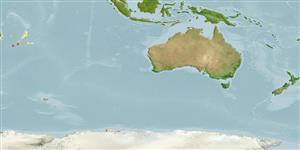分類 / Names
俗名 | 同種異名 | Catalog of Fishes(屬, 種) | ITIS | CoL | WoRMS | Cloffa
Teleostei >
Gobiiformes (Gobies)
鱸形目 (Gobies) >
Gobiidae (Gobies)
鰕虎魚科 (Gobies) > Gobiinae
Etymology: Trimma: Greek, trimma, -atos = something crushed (Ref. 45335); bisella: Name from Latin 'bi' meaning two, and 'sella' meaing a seat or saddle, referring to the two white saddle-like markings on the dorsal and ventral margins of the caudal peduncle; noun in apposition.. This species has been informally referred to as "Trimma RW sp. 53 (in lit.).".
More on author: Winterbottom.
Environment: milieu / climate zone / depth range / distribution range
生態學
海洋 居於水底的; 深度上下限 24 - 33 m (Ref. 118045). 熱帶
Western Indian Ocean: Mauritius.
西印度洋: 模里西斯。
大小 / 重量 / 年齡
Maturity: Lm ? range ? - ? cm
Max length : 2.4 cm SL 雄魚/尚未辨別雌雄; (Ref. 118045)
背棘 (總數) : 7; 背的軟條 (總數) : 9 - 10; 臀棘: 1; 臀鰭軟條: 8 - 9. This species is distinguished by the following characters: colour pattern distinguishes this species where freshly collected specimens have a brown-grey body; a bright red peduncle margined dorsally and ventrally by two large white saddles; vertical orange bars 4 on a salmon background on the head; midline of nape naked; interorbital trench well developed, second dorsal spine elongated, fifth pelvic fin ray unbranched; when preserved, the two light saddles on the caudal peduncle and the light vertical bars on the head visible; without scales in the predorsal midline or on cheek (Ref. 118045).
Life cycle and mating behavior
成熟度 | 繁殖 | 產卵場 | 卵 | 孕卵數 | 仔魚
西印度洋: 模里西斯。
Winterbottom, R., 2000. Four new species of Trimma (Gobiidae), from the Indian and western Pacific Oceans. aqua, J. Ichthyol. Aquat. Biol. 4(2):57-66. (Ref. 118045)
IUCN 瀕危狀態 (Ref. 130435: Version 2024-2)
無危 (LC) ; Date assessed: 19 July 2017
人類使用
漁業: 沒有興趣
工具
特別的報告
下載 XML
網路資源
Estimates based on models
Phylogenetic diversity index (Ref.
82804): PD
50 = 0.5000 [Uniqueness, from 0.5 = low to 2.0 = high].
Bayesian length-weight: a=0.01023 (0.00477 - 0.02194), b=3.01 (2.83 - 3.19), in cm total length, based on LWR estimates for this (Sub)family-body shape (Ref.
93245).
回復力 (Ref.
120179): 高度, 族群倍增時間少於 15個月 (Preliminary K or Fecundity.).
Fishing Vulnerability (Ref.
59153): Low vulnerability (10 of 100).
